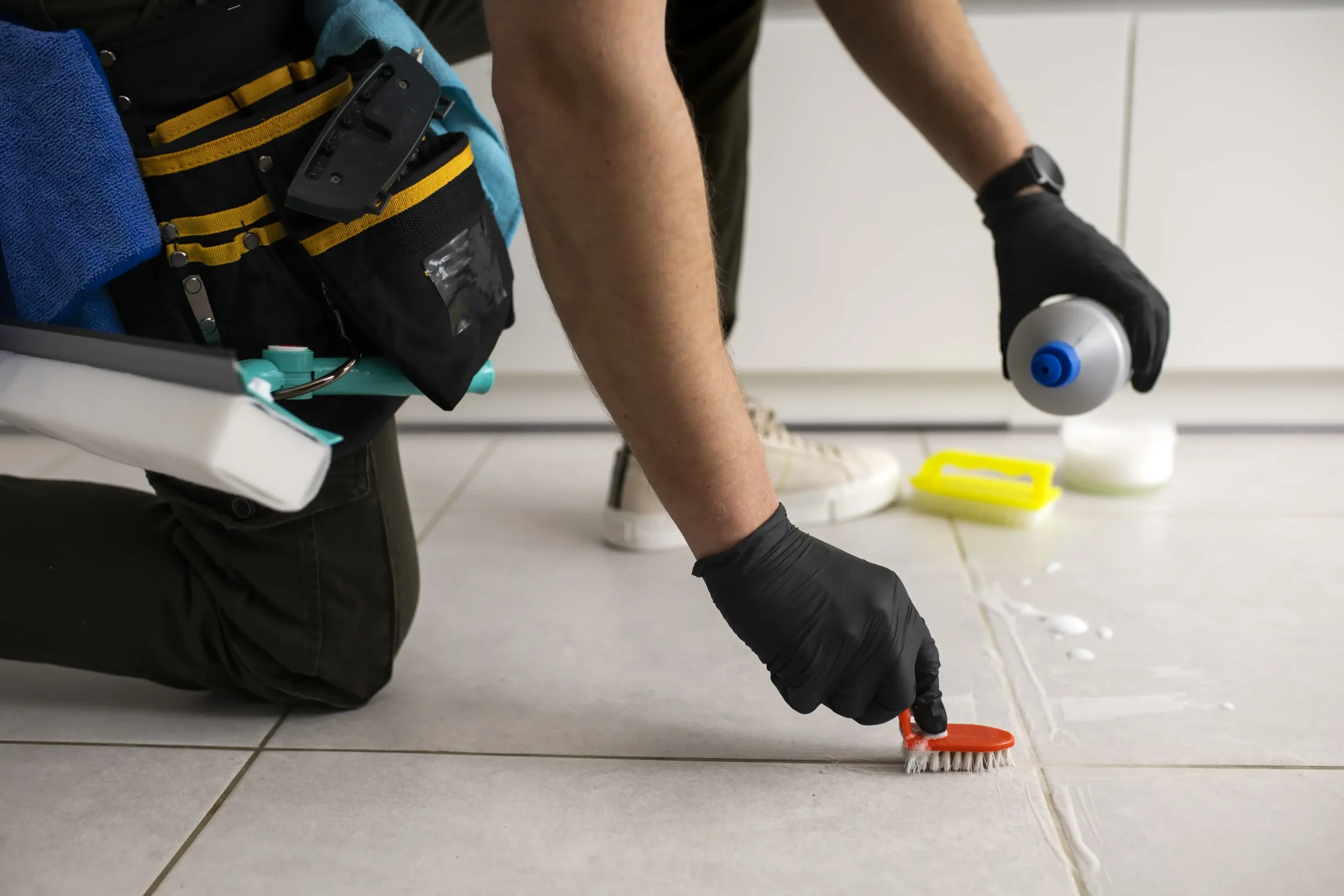🕓 Last updated: September 21, 2025
What Is Clean Floor Tile Grout?
Clean floor tile grout refers to grout lines that are free from dirt, mold, stains, and discoloration—enhancing the overall look of your tile floor. While tiles may stay shiny, grout is porous and easily traps grime, causing the floor to look dull and dirty. Over time, even well-maintained tiles can lose their appeal due to grimy grout. If you’re looking to clean floor tile grout and restore your floor’s original beauty, this guide walks you through the most effective methods, tools, products, and DIY solutions—whether your tiles are ceramic, porcelain, or natural stone.
The Importance of Cleaning Floor Tile Grout Regularly
Neglecting to clean floor tile grout can do more than just dull your floor’s appearance—it can cause serious issues, including:
- Permanent discoloration
- Mold and mildew buildup
- Lingering unpleasant odors
- Weakening of the grout structure
- Increased risk of bacterial growth
When you clean floor tile grout regularly, you not only maintain a fresh, polished look but also protect your home’s hygiene and extend the life of your flooring.
Pre-Cleaning Tips Before You Start
Before you dive into grout cleaning, follow these basic steps:
Sweep or vacuum the entire floor to remove loose dust and debris.
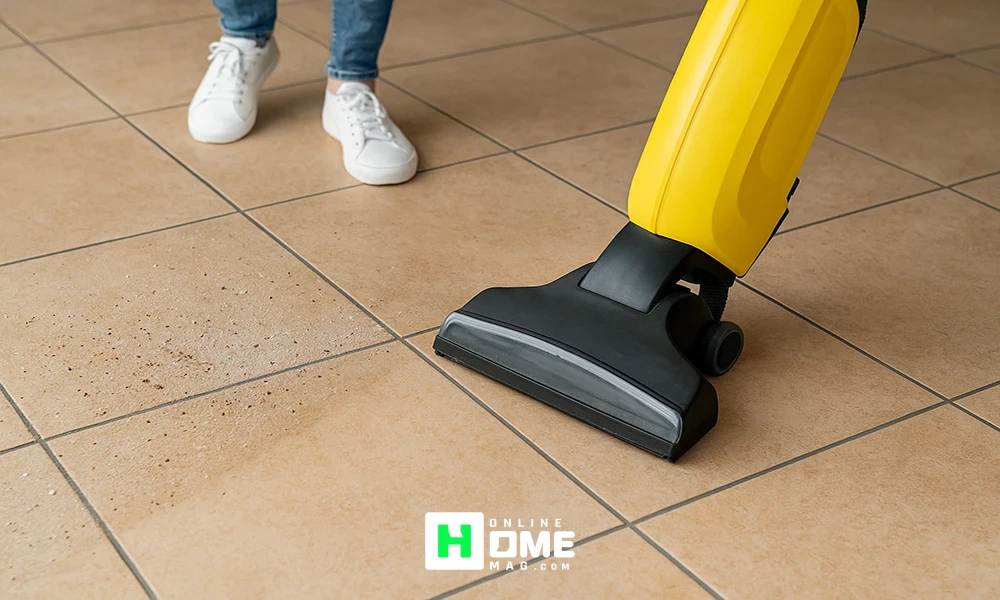
Spot test your chosen cleaner on a small, hidden section of grout.
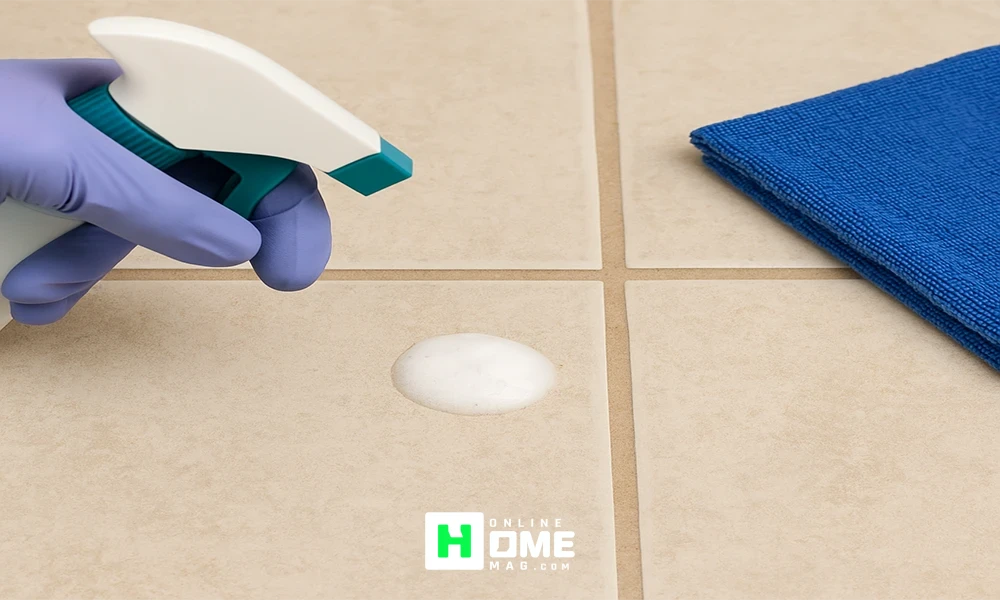
Choose the right method based on the level of staining and type of tile.
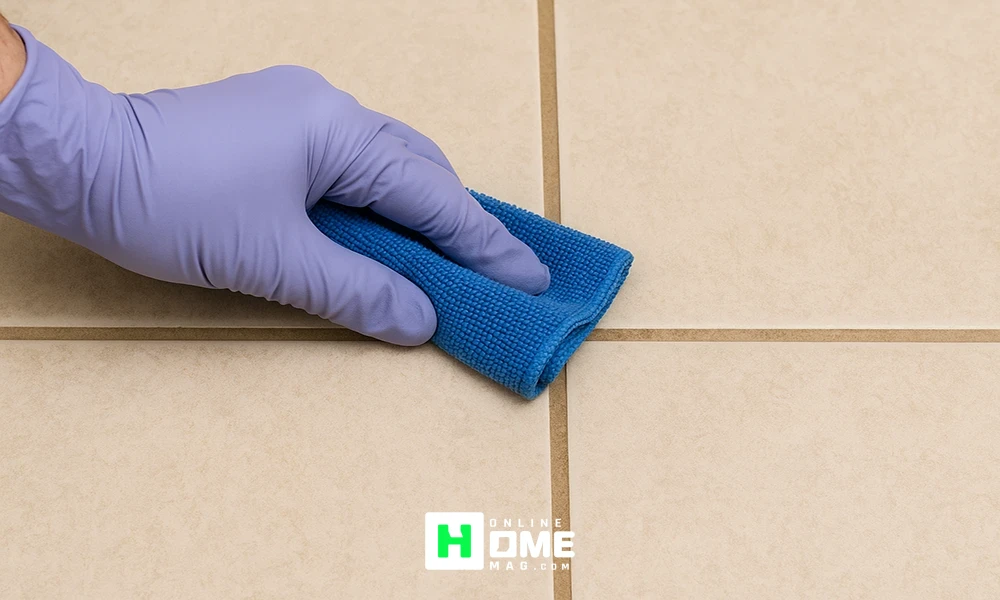
Best Homemade Cleaner to Clean Floor Tile Grout with Light Stains
If your grout is only lightly discolored, a simple DIY solution can help clean floor tile grout effectively—without harsh chemicals.
Baking Soda + Vinegar Paste
Ingredients:
- 1/2 cup baking soda
- 1/4 cup white vinegar
- Water (as needed)
Instructions:
- Mix the baking soda and vinegar into a spreadable paste.
- Apply it directly to grout lines.
- Let it sit for 5–10 minutes.
- Scrub with a toothbrush or grout brush.
- Wipe clean with a damp cloth or mop.
Why it works:
Baking soda provides gentle abrasion to lift surface stains, while vinegar helps dissolve grime—making this a reliable way to clean floor tile grout naturally.
Heavy-Duty Homemade Grout Cleaner
If the dirt is deeper or mold has set in, try this more powerful solution.
Hydrogen Peroxide + Baking Soda Scrub
Ingredients:
- 1/2 cup baking soda
- 1/4 cup hydrogen peroxide
- 1 tsp dish soap
Instructions:
- Combine all ingredients in a bowl.
- Apply the mixture to grout and let it sit for 10–15 minutes.
- Scrub vigorously.
- Rinse with warm water and wipe dry.
This solution is great for brightening grout and killing mold spores.
Commercial Grout Cleaners: What to Look For
Not into DIY? No problem. Several store-bought options are formulated specifically for grout.
Features to look for:
• pH-balanced for tile safety
• Non-corrosive (safe on natural stone)
• Contains oxygen bleach (for whitening)
• Mold/mildew resistance
Popular options:
• Zep Grout Cleaner
• Soft Scrub with Bleach
• CLR Bath & Kitchen Cleaner
• Black Diamond Ultimate Grout Cleaner
Always read the label for surface compatibility and safety precautions.
Using a Steam Cleaner on Tile Grout
One of the most effective and chemical-free ways to clean grout is with steam.
Why steam cleaning works:
- High heat loosens grime embedded in porous grout.
- Kills bacteria and mold without chemicals.
- No residue left behind.
How to use:
- Fill your steam cleaner with distilled water.
- Use a grout-specific attachment or brush nozzle.
- Slowly run over each grout line.
- Wipe excess moisture with a microfiber cloth.
Pro tip: Avoid using steam on unsealed or cracked grout, as moisture could seep in and worsen the damage.
Best Tools for Cleaning Floor Tile Grout
Having the right tools can make all the difference. Here are essentials for grout success:
- Grout brush – Designed to fit into narrow lines and provide strong scrubbing.
- Old toothbrush – Great for smaller areas or delicate surfaces.
- Drill brush attachment – If you’re tackling a large area, power tools speed things up.
- Microfiber cloth or mop – For wiping and drying after cleaning.
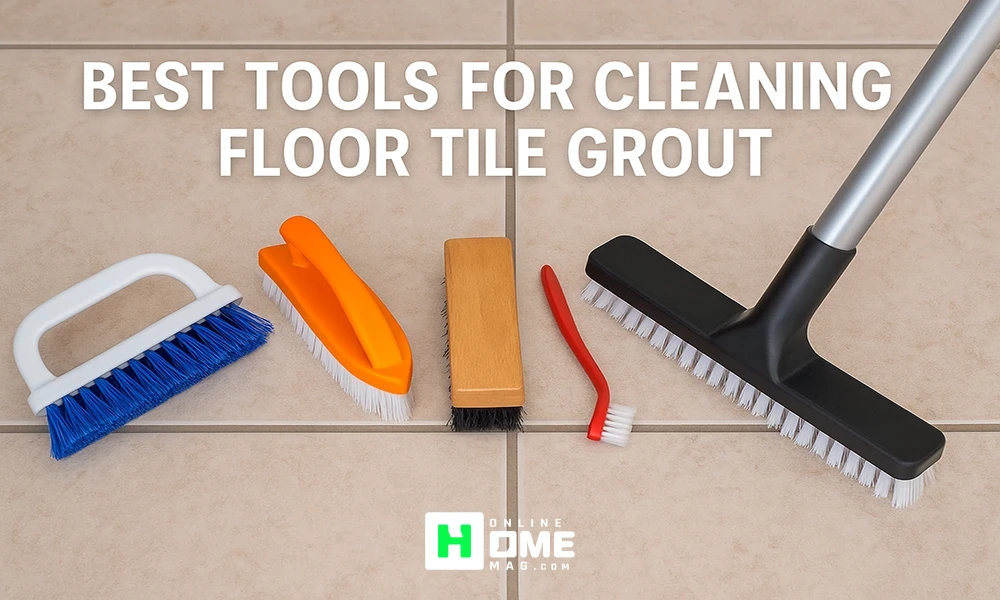
How to Whiten Grout Safely
White grout is beautiful when new—but it can quickly look yellow or gray. Here’s how to restore the original brightness:
Option 1: Oxygen Bleach Soak
- Mix oxygen bleach powder with warm water.
- Pour over grout lines and let sit for 10–15 minutes.
- Scrub and rinse.
Option 2: Grout Pen
- For stubborn stains that won’t lift, a grout pen offers a cosmetic fix.
- These are like paint pens and recolor the grout, making it look new.
Avoid using chlorine bleach, which can degrade grout over time and damage nearby tile.
How Often Should You Clean Grout?
To maintain clean grout, follow this schedule:
- Spot clean weekly – Wipe up spills quickly, especially in kitchens and bathrooms.
- Deep clean monthly – Use a brush and cleaner to scrub away buildup.
- Reseal grout every 6–12 months – Especially for high-traffic or moisture-prone areas.
Regular maintenance is easier (and cheaper) than waiting for a full restoration.
Sealing Grout: Your Best Defense Against Stains
Once your grout is clean, sealing it protects your hard work.
Benefits of sealing grout:
- Prevents future staining
- Reduces mold growth
- Makes cleaning easier
- Extends grout life
How to seal grout:
- Wait 24–48 hours after cleaning.
- Apply grout sealer with a small brush or applicator bottle.
- Let dry fully (check product instructions).
- Reapply every 6–12 months.
Natural stone or light-colored grout may require more frequent sealing.
What NOT to Do When Cleaning Grout
Cleaning grout improperly can do more harm than good. Avoid these mistakes:
- Using harsh acids – Can erode grout or discolor natural stone.
- Scrubbing with wire brushes – May damage tile surfaces or widen grout lines.
- Using bleach excessively – Temporarily whitens, but weakens grout and releases fumes.
- Skipping sealing – Leaves grout vulnerable to re-staining.
Always use tile-safe products and test new cleaners on a small patch first.
Can You Clean Grout Without Scrubbing?
If scrubbing is too much effort, you can try spray-on foam cleaners or steam methods. However, some light scrubbing will almost always be necessary for deeper stains.
To minimize effort:
- Use cleaning solutions that “sit and soak” for longer.
- Use warm water to activate ingredients.
- Let natural enzymes (in bio-cleaners) do the work over time.
Natural Alternatives to Clean Floor Tile Grout
Looking for eco-friendly ways to clean floor tile grout? Skip harsh chemicals and try these natural solutions instead:
- Lemon juice – Its natural acidity helps break down surface stains on grout.
- Tea tree oil mixed with water – A gentle, antifungal option perfect for grout in humid, mildew-prone spaces.
- Vinegar infused with citrus peels – This DIY cleaner not only helps clean floor tile grout but also leaves a fresh scent behind.
While these natural cleaners may not be as strong as commercial options, they’re ideal for regular maintenance and light cleaning.

Cleaning Grout Between Different Types of Tiles
Not all tiles are created equal—adjust your cleaning based on the tile material:
| Tile Type | Grout Cleaning Tip |
| Ceramic/Porcelain | Most forgiving; safe to use vinegar or baking soda mixes. |
| Natural Stone | Avoid vinegar or acidic solutions; use pH-neutral cleaners. |
| Glass Tile | Use gentle brushes; avoid abrasive cleaners. |
| Slate | Seal both grout and stone; avoid bleach-based products. |
Always verify your tile type before choosing your cleaning method.
How to Clean Floor Tile Grout Without Damaging Your Tiles
To clean floor tile grout effectively without harming your tile surface, follow these gentle yet powerful tips:
- Always use a soft-bristled brush to scrub the grout — this helps clean floor tile grout without scratching the tiles.
- Go for non-abrasive, pH-neutral cleaners that lift dirt without corroding the surface.
- Avoid leaving acidic solutions on tiles, as they can erode the finish over time.
- Finally, rinse well and dry the area completely to prevent moisture-related damage or water spots.
These methods ensure your grout gets clean while your tiles stay pristine.
Signs It’s Time to Replace Your Grout
Sometimes, no amount of cleaning will fix cracked, moldy, or deteriorating grout. Signs that you may need professional regrouting include:
- Cracks or holes in grout lines
- Persistent mold despite cleaning
- Loose tiles or crumbling grout
- Discoloration that won’t lift
Replacing grout is a more intensive process but revitalizes the look and structure of your floor. Clean grout may seem like a small detail, but it has a huge impact on your home’s appearance and hygiene. Just like when you remove pet stains from carpet to restore freshness, consistent grout cleaning transforms the overall look of a space. Whether you prefer natural DIY methods, powerful commercial cleaners, or steam tools, the key is consistency. With the right approach, your grout can look as fresh and bright as the day it was installed.

